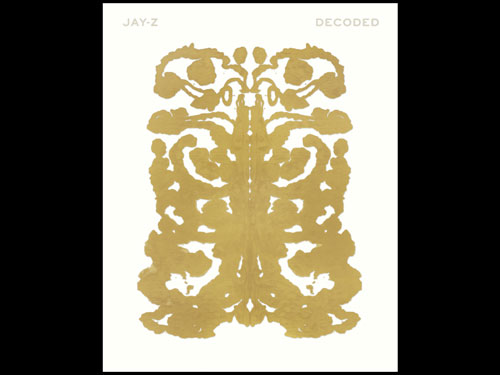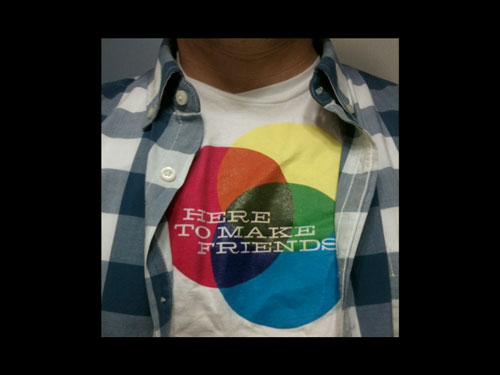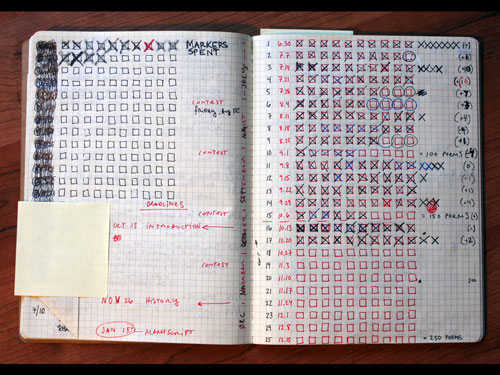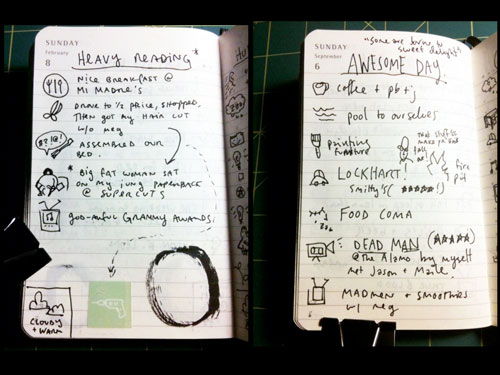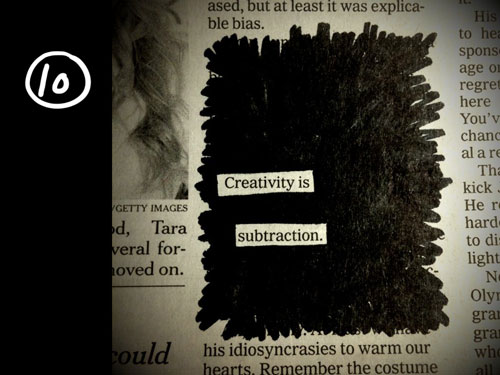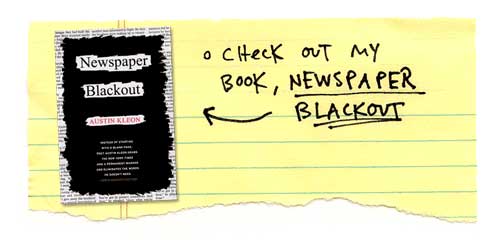Friday, April 29, 2011
Thursday, April 28, 2011
Dear Fox/Donald Trump/Republicans: Now You Can Shut Up

Congratulations to Fox News, certain Republicans (they know who they are), and Donald Trump.
You have successfully wasted countless hours/days/weeks/months/years
dedicated to proving this document existed even though
birth information was released by the state almost 4 years ago.
Let's try and focus on things that matter. No, that doesn't matter either, Donald.
dedicated to proving this document existed even though
birth information was released by the state almost 4 years ago.
Let's try and focus on things that matter. No, that doesn't matter either, Donald.
Tuesday, April 26, 2011
Cleveland Attempts To Be Healthier
This is pretty comical considering Progressive Field serves
chicken fried waffles and fried cookie dough, but it's a step in the right direction
Monday, April 25, 2011
Russell Brand on Celebrity
I didn't have much of an opinion of Russell Brand until I saw this interview.
Very well spoken and thoughtful answers to some tough questions.
A War Within - Winner of Best Film/Best Drama
My friends just won Best Film and Best Drama for A War Within
at Lake Erie College's 2011 Film Festival. Check it out and subscribe to
Saturday, April 23, 2011
Sushi and Beer, You're In The Clear

When this is your meal to start out the day, you know it's going to be a good day.
If you weren't aware, Thirsty Dog's Old Leghumper (Porter) out of Akron is delicious.
Friday, April 22, 2011
This American Life - The Weiner Circle in Chicago
This American Life on Showtime is one of my favorite shows on TV.
It has some incredible stories about people in America.
This particular episode about The Weiner Circle was particularly interesting.
I'm interested to check it out the next time I'm in Chicago.
100 Abandoned Houses in Detroit
‘I decided to name the series 100 Abandoned Houses. 100 seemed like a lot, although the number of abandoned houses in Detroit is more like 12,000.
Encompassing an area of over 138 square miles, Detroit has enough room to hold the land mass of San Francisco, Boston, and Manhattan Island, yet the population has fallen from close to 2 million citizens, to most likely less than 800,000. With such a dramatic decline, the abandoned house problem is not likely to go away any time soon.’
- Kevin Bauman, 100 Abandoned Houses




Thursday, April 21, 2011
Harvard Sailing Team - Boys Will Be Girls: Bixby the Cat
I hope these guys never stop making "Boys Will Be Girls" videos.
Flaming Lips Release 4 New Songs... In Gummi-Skulls

This is why I love the Flaming Lips.
Yesterday they released 4 new songs that were put on 5 single zip drives placed inside
life-size skulls made out of the same stuff that gummi bears are made of.
They were only sold at a local Oklahoma City record store,
which is the hometown of the band.
Go to Some Kind of Awesome to hear the new songs.
This Photo of a Lion's Mane Jellyfish Better Be Fake

So there's a real thing called the Lion's Mane Jellyfish. But this photo can't be real, right?
Because that's scary as shit. Comments?
Monday, April 18, 2011
Gotta Groove Records
I had no idea Cleveland has a vinyl record manufacturer.
Making a note to visit Gotta Groove Records.
Making a note to visit Gotta Groove Records.
The Fab Five
This documentary about the Fab Five
(Chris Webber, Juwan Howard, Jalen Rose, Jimmy King and Ray Jackson)
is definitely worth a watch.
Friday, April 15, 2011
Thursday, April 14, 2011
Jeni's Splendid Ice Creams
If you haven't tried Jeni's Splendid Ice Cream yet, TRY IT. It's fucking delicious. Just sayin.
I tried the Goat Cheese with Cognac Fig Sauce thinking "There is no way this could taste good".
It did. I'm sold. Vodka Is Stupid: Stop Wasting Money On Top-Shelf Vodka
Interesting article from Jen Agg, part owner of a Toronto restaurant called The Black Hoof.
I'll have to reconsider what goes in the next Martini I get...
I'll have to reconsider what goes in the next Martini I get...
Vodka is Stupid
February 14, 2011 — By Jen Agg
The problem with vodka is that it’s dumb. As a restaurateur, I’d love to not even offer it at all, especially since at The Black Hoof not serving the world’s most popular spirit would certainly go along with the theme of doing things a little bit differently. But offer it, I do, although usually with a diatribe attached or a gentle nudge toward the much more interesting gin. Unfortunately, most people don’t like diatribes implying that their drink of choice is dumb. It makes them feel like I’m saying they’re dumb. And since my job is without a doubt in customer service I stock the affordable and perfectly acceptable Canadian Iceberg. For what it lacks in snazzy marketing and bottle design, it makes up for in tasting…like nothing.
That is the goal of vodka; to taste like nothing. And that is why it is dumb.
We’ve been assaulted by the marketing of high-end brands like Belvedere and Grey Goose into believing they are items of luxury. But they are only luxury items because they are expensive. Very expensive. Companies like Grey Goose need to justify that expense, and here’s how they do it:
“Grey Goose vodka is crafted from the finest French wheat, with water naturally filteredover champagne limestone and carefully distilled according to the uncompromising traditions of France’s Cognac region. Each batch is made to the exacting standards of Francois Thibault, Maitre De Chai, ensuring its distinct freshness, clarity and unparalleled smoothness. Unlike any other vodka in the world.”
Ouch. First of all, who is Francois Thibault? Well, his official title is “Maitre de Chai”, which means cellar master and is usually associated with the ageing of wine. Now this all seems a little suspect considering vodka isn’t aged. Seems he’s more in charge of “making things fancy by having a fancy title”, but that doesn’t have the same ring to it. And how does anything in the process, other than the words “natural”, “traditions” and “standards” justify a $40 price tag? It simply doesn’t.
It’s outrageous to charge $40 for a bottle of plain spirit that has not been given any flavour or character by the addition of herbs and spices, like gin, or aged in oak barrels for complexity and softness, like scotch. Vodka’s only claim to fame is that it tastes like LESS of something. I mean, really, that’s what the brand marketing is trying to tell you. The less flavour the product has, the better it is. And smooth? That’s usually just glycerin, a harmless additive used to give some liquors a fuller, smoother mouth feel.
Vodka is made with vegetables or grains, distilled, diluted with water and bottled. I would guess the manufacturing of the bottles costs more than the contents. It is not special or time consuming, has nothing to do with terroir and doesn’t wear the character of its maker in subtleties of flavour.
Despite it’s basic-ness, it has captured the attention of the worlds drinkers. It has certainly stepped outside its Polish roots (although Russia has been an excellent Godfather). At the beginning of the 20th century vodka comprised almost 90% of all liquor consumed in Russia. Of course, this was after the government dropped its policy of promoting consumption of state produced vodka which caused the price to plummet and made the warming spirit available to the masses at an irresistible price. Almost as cheap as water, vodka’s namesake It’s derived from “voda”, Slavic for water.
North American imbibers didn’t pay much attention until the late 60′s, but a campaign from Smirnoff that vodka “leaves you breathless” made a huge impact on the market and by 1975 vodka sales in America surpassed those of hometown favourite, bourbon. It seems people were so happy to believe the lie that vodka doesn’t leave that tell-tale boozy smell on your breath that they didn’t mind giving up flavour. Having made many, many vodka martinis for friends and customers, I can assure you that the scent it leaves on ones breath is distinctly and obviously alcohol.
So the success of vodka is based on a 40 year old marketing campaign that it leaves you breathless, mixes well as it doesn’t interfere with other flavours. Really, how could it? And is cheap enough to produce to have been the drink of choice in wartime Russia.
But what’s good about it? Nothing, really.
A vodka martini ought to be renamed “I like being drunk” because that is its only purpose. Whereas the pleasure of sipping a well-made Manhattan is its own fun, the slight buzzy inhibitions of alcohol, just a pleasing side effect. Why wouldn’t you want your drink to taste like anything?
But it’s not fair to compare a silly, boring drink like a vodka martini to a flavour bomb like The Manhattan. Even worse is the dirty vodka martini. If your desperation for flavour has you drinking olive brine, just drink gin. Please. Gin is vodka’s smarter, classier, more worldly older sister. Vodka wants to go clubbing and hook up with Johnny Redbull, that hot guy she met last week (who’s not actually that hot and wears too much cologne). Gin wants to have dinner, a little wine and really talk about stuff, like politics and indie rock.
So if your drink of choice is gin or rye or anything but vodka, you are doing the right thing by choosing a spirit based on its taste. If you’re a vodka sort, don’t worry too much, you are right in line with the masses. Just imagine how proud your grandchildren will be of you for toeing the vodka party line.
(Charcuteri Sundays, The Fox Is Black)
That is the goal of vodka; to taste like nothing. And that is why it is dumb.
We’ve been assaulted by the marketing of high-end brands like Belvedere and Grey Goose into believing they are items of luxury. But they are only luxury items because they are expensive. Very expensive. Companies like Grey Goose need to justify that expense, and here’s how they do it:
“Grey Goose vodka is crafted from the finest French wheat, with water naturally filteredover champagne limestone and carefully distilled according to the uncompromising traditions of France’s Cognac region. Each batch is made to the exacting standards of Francois Thibault, Maitre De Chai, ensuring its distinct freshness, clarity and unparalleled smoothness. Unlike any other vodka in the world.”
Ouch. First of all, who is Francois Thibault? Well, his official title is “Maitre de Chai”, which means cellar master and is usually associated with the ageing of wine. Now this all seems a little suspect considering vodka isn’t aged. Seems he’s more in charge of “making things fancy by having a fancy title”, but that doesn’t have the same ring to it. And how does anything in the process, other than the words “natural”, “traditions” and “standards” justify a $40 price tag? It simply doesn’t.
It’s outrageous to charge $40 for a bottle of plain spirit that has not been given any flavour or character by the addition of herbs and spices, like gin, or aged in oak barrels for complexity and softness, like scotch. Vodka’s only claim to fame is that it tastes like LESS of something. I mean, really, that’s what the brand marketing is trying to tell you. The less flavour the product has, the better it is. And smooth? That’s usually just glycerin, a harmless additive used to give some liquors a fuller, smoother mouth feel.
Vodka is made with vegetables or grains, distilled, diluted with water and bottled. I would guess the manufacturing of the bottles costs more than the contents. It is not special or time consuming, has nothing to do with terroir and doesn’t wear the character of its maker in subtleties of flavour.
Despite it’s basic-ness, it has captured the attention of the worlds drinkers. It has certainly stepped outside its Polish roots (although Russia has been an excellent Godfather). At the beginning of the 20th century vodka comprised almost 90% of all liquor consumed in Russia. Of course, this was after the government dropped its policy of promoting consumption of state produced vodka which caused the price to plummet and made the warming spirit available to the masses at an irresistible price. Almost as cheap as water, vodka’s namesake It’s derived from “voda”, Slavic for water.
North American imbibers didn’t pay much attention until the late 60′s, but a campaign from Smirnoff that vodka “leaves you breathless” made a huge impact on the market and by 1975 vodka sales in America surpassed those of hometown favourite, bourbon. It seems people were so happy to believe the lie that vodka doesn’t leave that tell-tale boozy smell on your breath that they didn’t mind giving up flavour. Having made many, many vodka martinis for friends and customers, I can assure you that the scent it leaves on ones breath is distinctly and obviously alcohol.
So the success of vodka is based on a 40 year old marketing campaign that it leaves you breathless, mixes well as it doesn’t interfere with other flavours. Really, how could it? And is cheap enough to produce to have been the drink of choice in wartime Russia.
But what’s good about it? Nothing, really.
A vodka martini ought to be renamed “I like being drunk” because that is its only purpose. Whereas the pleasure of sipping a well-made Manhattan is its own fun, the slight buzzy inhibitions of alcohol, just a pleasing side effect. Why wouldn’t you want your drink to taste like anything?
But it’s not fair to compare a silly, boring drink like a vodka martini to a flavour bomb like The Manhattan. Even worse is the dirty vodka martini. If your desperation for flavour has you drinking olive brine, just drink gin. Please. Gin is vodka’s smarter, classier, more worldly older sister. Vodka wants to go clubbing and hook up with Johnny Redbull, that hot guy she met last week (who’s not actually that hot and wears too much cologne). Gin wants to have dinner, a little wine and really talk about stuff, like politics and indie rock.
So if your drink of choice is gin or rye or anything but vodka, you are doing the right thing by choosing a spirit based on its taste. If you’re a vodka sort, don’t worry too much, you are right in line with the masses. Just imagine how proud your grandchildren will be of you for toeing the vodka party line.
(Charcuteri Sundays, The Fox Is Black)
Wednesday, April 13, 2011
How To Steal Like An Artist - Austin Kleon
Reposted from Austin Kleon - this is a great take on being creative.

1. Steal like an artist.
Every artist gets asked the question, “Where do you get your ideas?”
The honest artist answers, “I steal them.”
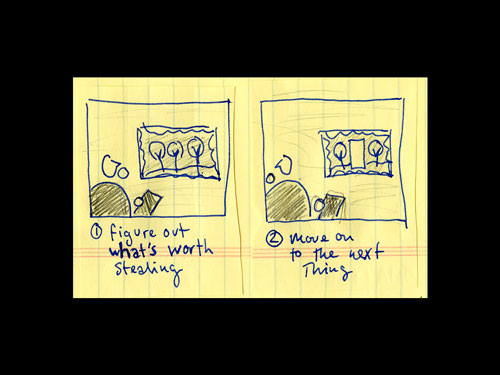
I drew this cartoon a few years ago. There are two panels. Figure out what’s worth stealing. Move on to the next thing.
That’s about all there is to it.
Here’s what artists understand. It’s a three-word sentence that fills me with hope every time I read it:
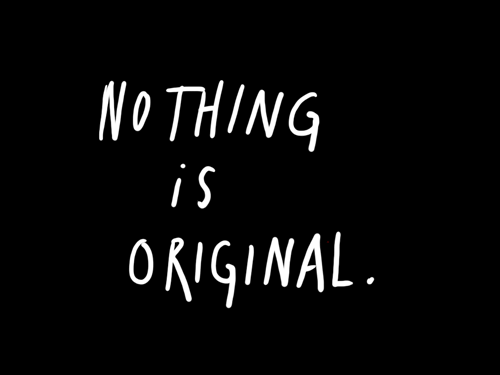
It says it right there in the Bible. Ecclesiastes:
That which has been is what will be, That which is done is what will be done, And there is nothing new under the sun.
Every new idea is just a mashup or a remix of previous ideas.

Here’s a trick they teach you in art school. Draw two parallel lines on a piece of paper:

How many lines are there? There’s the first line, the second line, but then there’s a line of negative space that runs between them. See it?
1 + 1 = 3.

Speaking of lines, here’s a good example of what I’m talking about: genetics. You have a mother and you have a father. You possess features from both of them, but the sum of you is bigger than their parts. You’re a remix of your mom and dad and all of your ancestors.

You don’t get to pick your family, but you can pick your teachers and you can pick your friends and you can pick the music you listen to and you can pick the books you read and you can pick the movies you see.
Jay-Z talks about this in his book, Decoded:
We were kids without fathers…so we found our fathers on wax and on the streets and in history, and in a way, that was a gift. We got to pick and choose the ancestors who would inspire the world we were going to make for ourselves…Our fathers were gone, usually because they just bounced, but we took their old records and used them to build something fresh.
You are, in fact, a mashup of what you choose to let into your life. You are the sum of your influences. The German writer Goethe said, “We are shaped and fashioned by what we love.”

An artist is a collector. Not a hoarder, mind you, there’s a difference: hoarders collect indiscriminately, the artist collects selectively. They only collect things that they really love.
There’s an economic theory out there that if you take the incomes of your five closest friends and average them, the resulting number will be pretty close to your own income.
I think the same thing is true of our idea incomes. You’re only going to be as good as the stuff you surround yourself with.
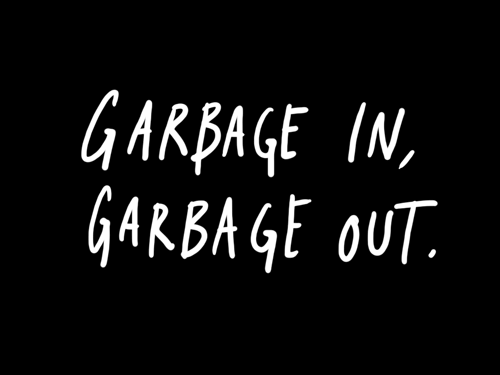
My mom used to say to me, “Garbage in, garbage out.”
It used to drive me nuts. But now I know what she means.
Your job is to collect ideas. The best way to collect ideas is to read. Read, read, read, read, read. Read the newspaper. Read the weather. Read the signs on the road. Read the faces of strangers. The more you read, the more you can choose to be influenced by.

Identify one writer you really love. Find everything they’ve ever written. Then find out what they read. And read all of that. Climb up your own family tree of writers.
Steal things and save them for later. Carry around a sketchpad. Write in your books. Tear things out of magazines and collage them in your scrapbook.
Steal like an artist.

2. Don’t wait until you know who you are to start making things.
There was a video going around the internet last year of Rainn Wilson, the guy who plays Dwight on The Office. He was talking about creative block, and he said this thing that drove me nuts, because I feel like it’s a license for so many people to put off making things: “If you don’t know who you are or what you’re about or what you believe in it’s really pretty impossible to be creative.”
If I waited to know “who I was” or “what I was about” before I started “being creative”, well, I’d still be sitting around trying to figure myself out instead of making things. In my experience, it’s in the act of making things that we figure out who we are.

You’re ready. Start making stuff.
You might be scared. That’s natural.
There’s this very real thing that runs rampant in educated people. It’s called imposter syndrome. The clinical definition is a “psychological phenomenon in which people are unable to internalize their accomplishments.” It means that you feel like a phony, like you’re just winging it, that you really don’t have any idea what you’re doing.
Guess what?
None of us do. I had no idea what I was doing when I started blacking out newspaper columns. All I knew was that it felt good. It didn’t feel like work. It felt like play.
Ask any real artist, and they’ll tell you the truth: they don’t know where the good stuff comes from. They just show up to do their thing. Every day.
Have you ever heard of dramaturgy? It’s a fancy sociological term for something this guy in England said about 400 years ago:
All the world’s a stage,
And all the men and women merely players:
They have their exits and their entrances;
And one man in his time plays many parts…
Another way to say this:

I love this phrase. There’s two ways to read it: Fake it ‘til you make it, as in, fake it until you’re successful, until everybody sees you the way you want, etc. Or, fake it til’ you make it, as in, pretend to be making something until you actually make something. I love that idea.
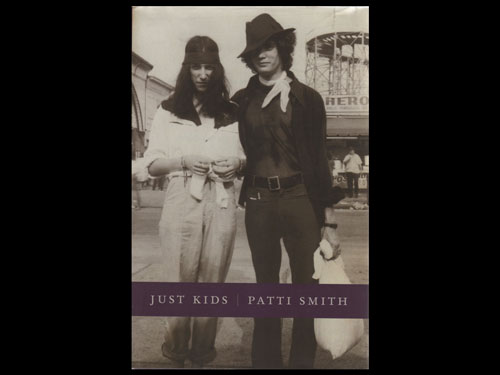
I also love the book Just Kids by Patti Smith. I love it because it’s a story about how two friends moved to New York and learned to be artists. You know how they learned to be artists? They pretended to be artists. I’ll spoil the book for you and describe my favorite scene, the turning scene in the book: Patti Smith and her friend Robert Maplethorpe dress up in all their gypsy gear and they go to Washington Square, where everybody’s hanging out, and this old couple kind of gawks at them, and the woman says to her husband, “Oh, take their picture. I think they’re artists.” “Oh, go on,” he shrugged. “They’re just kids.”
The point is: all the world’s a stage. You need a stage and you need a costume and you need a script. The stage is your workspace. It can be a studio, a desk, or a sketchbook. The costume is your outfit, your painting pants, or your writing slippers, or your funny hat that gives you ideas. The script is just plain old time. An hour here, or an hour there. A script for a play is just time measured out for things to happen.
Fake it ’til you make it.
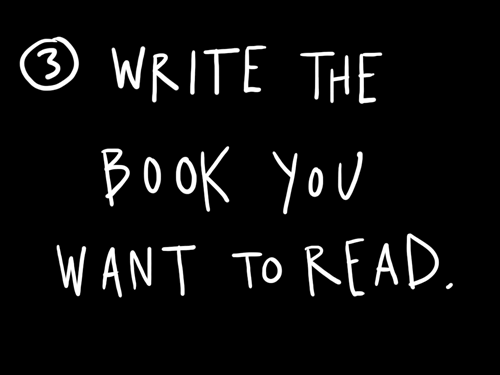
3. Write the book you want to read.
Quick story:
Jurassic Park came out on my 10th birthday. I loved it. I was kind of obsessed with it. I mean, what 10-year-old wasn’t obsessed with that movie? The minute I left my little small-town theater, I was dying for a sequel.
I sat down the next day at our old green-screen PC and typed out a sequel. In my treatment, the son of the game warden eaten by velociraptors goes back to the island with the granddaughter of the guy who built the park. See, one wants to destroy the rest of the park, the other wants to save it. Of course, they fall in love and adventures ensue.
I didn’t know it at the time, but I was writing what we now call fan fiction—fictional stories based on characters that already exist.
10-year-old me saved the story to the hard drive.
Then, a few years later, Jurassic Park 2 came out.
And it sucked.
The sequel *always* sucks compared to the sequel in our heads.
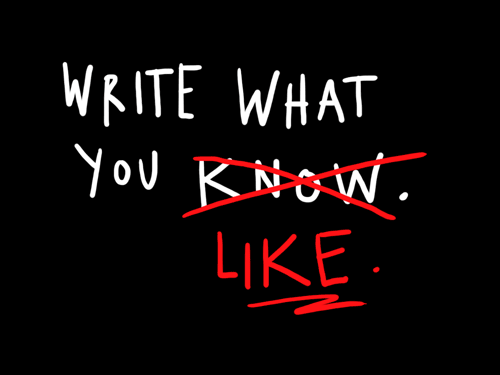
The question every young writer asks is: “What should I write?”
And the cliched answer is, “Write what you know.”
This advice always leads to terrible stories in which nothing interesting happens.
The best advice is not to write what you know, it’s write what you *like*.
Write the kind of story you like best.
We make art because we like art.
All fiction, in fact, is fan fiction.
The best way to find the work you should be doing is to think about the work you want to see done that isn’t being done, and then go do it.
Draw the art you want to see, make the music you want to hear, write the books you want to read.

4. Use your hands.
My favorite cartoonist, Lynda Barry, she has this saying: “In the digital age, don’t forget to use your digits! Your hands are the original digital devices.”
When I was in creative writing workshops in college, all manuscripts had to be in double-spaced, Times New Roman font. And my stuff was just terrible. It wasn’t until I started making writing with my hands that writing became fun and my work started to improve.
The more I stay away from the computer, the better my ideas get. Microsoft Word is my enemy. I use it all the time at work. I try to stay away from it the rest of my life.
I think the more that writing is made into a physical process, the better it is. You can feel the ink on paper. You can spread writing all over your desk and sort through it. You can lay it all out where you can look at it.
People ask me why I don’t develop an iPhone or iPad Newspaper Blackout app, and I tell them because I think there is magic in feeling the newsprint in your hand and the words disappearing under that marker line. A lot of your senses are engaged–even the smell of the fumes add to the experience.

Art that only comes from the head isn’t any good. Watch any good musician and you’ll see what I mean.
When I’m making the poems, it doesn’t feel like work. It feels like play.
So my advice is to find a way to bring your body into your work. Draw on the walls. Stand up when you’re working. Spread things around the table.
Use your hands.
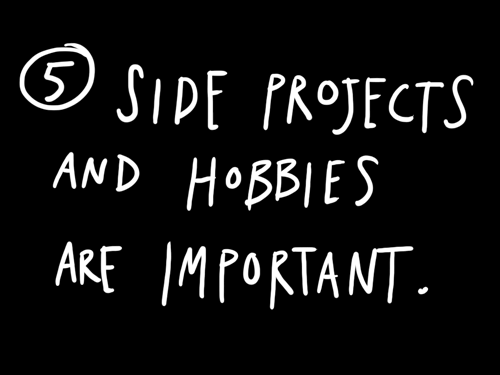
5. Side projects and hobbies are important.
Speaking of play — one thing I’ve learned in my brief tenure as an artist: it’s the side projects that blow up.
By side projects I mean the stuff that you thought was just messing around. Stuff that’s just play. That’s actually the good stuff. That’s when the magic happens.
The blackout poems were a side project. Had I been focused only on my goal of writing short fiction, had I not allowed myself the room to experiment, I’d never be where I am now.

It’s also important to have a hobby. Something that’s just for you. Music is my hobby. (That’s me at Guitar Center.)
While my art is for the world to see, music is for me and my friends. We get together every Sunday and make noise for a couple of hours. It’s wonderful.
So the lesson is: take time to mess around. Have a hobby. It’s good for you, and you never know where it may lead you…
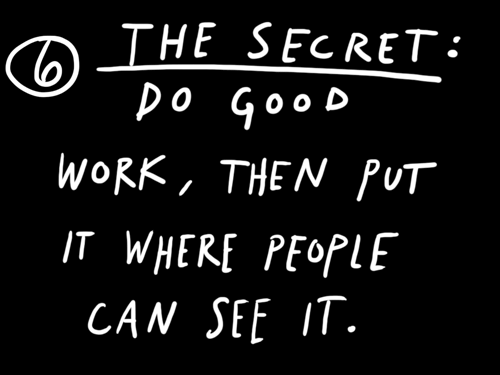
6. The secret: do good work and put it where people can see it.
I get a lot of e-mails from young artists who ask how they can find an audience. “How do I get discovered?”
I sympathize with them. There was a kind of fallout that happened when I left college. The classroom is a wonderful, if artificial place: your professor gets paid to pay attention to your ideas, and your classmates are paying to pay attention to your ideas.
Never in your life will you have such a captive audience.
Soon after, you learn that most of the world doesn’t necessarily care about what you think. It sounds harsh, but it’s true. As Steven Pressfield said, “It’s not that people are mean or cruel, they’re just busy.”
If there was a secret formula for getting an audience, or gaining a following, I would give it to you. But there’s only one not-so-secret formula that I know: “Do good work and put it where people can see it.”
It’s a two step process.
Step one, “do good work,” is incredibly hard. There are no shortcuts. Make stuff every day. Fail. Get better.
Step two, “put it where people can see it,” was really hard up until about 10 years ago. Now, it’s very simple: “put your stuff on the internet.”
I tell people this, and then they ask me, “What’s the secret of the internet?”
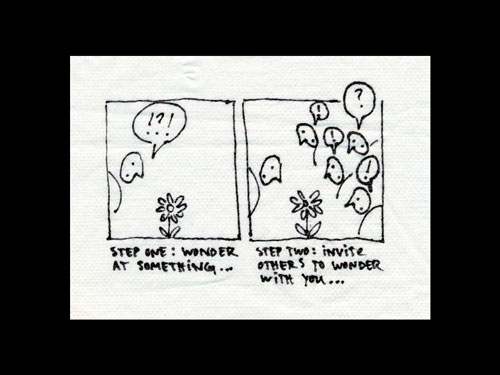
Step 1: Wonder at something. Step 2: Invite others to wonder with you.
You should wonder at the things nobody else is wondering about. If everybody’s wondering about apples, go wonder about oranges.
One of the things I’ve learned as an artist is that the more open you are about sharing your passions, the more people love your art.
Artists aren’t magicians. There’s no penalty for revealing your secrets.

Believe it or not, I get a lot of inspiration from people like Bob Ross and Martha Stewart. Bob Ross taught people how to paint. He gave his secrets away. Martha Stewart teaches you how to make your house and your life awesome. She gives her secrets away.
People love it when you give your secrets away, and sometimes, if you’re smart about it, they’ll reward you by buying the things you’re selling.
When you open up your process and invite people in, you learn. I’ve learned so much from the folks who submit poems to the Newspaper Blackout site. I find a lot of things to steal, too. It benefits me as much as it does them.
So my advice: learn to code. Figure out how to make a website. Figure out blogging. Figure out Twitter and all that other stuff. Find people on the internet who love the same things as you and connect with them. Share things with them.

7. Geography is no longer our master.
I’m so glad I’m alive right now.

I grew up in the middle of a cornfield in Southern Ohio. When I was a kid, all I wanted to do was hang out with artists. All I wanted to do was get the heck out of southern Ohio and get someplace where something was happening.
Now I live in Austin, Texas. A pretty hip place. Tons of artists and creative types everywhere.
And you know what? I’d say that 90% of my mentors and peers don’t live in Austin, Texas. They live on the internet.
Which is to say, most of my thinking and talking and art-related fellowship is online.
Instead of a geographical art scene, I have Twitter buddies and Google Reader.
Life is weird.
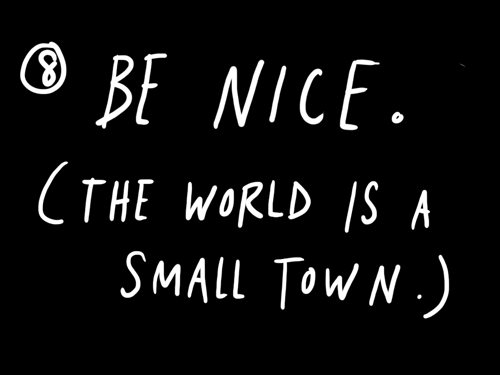
8. Be nice. The world is a small town.
I’ll keep this short. There’s only one reason I’m here. I’m here to make friends.
Kurt Vonnegut said it best: “There’s only one rule I know of: goddamn it, you’ve got to be kind.”
The golden rule is even more golden in our hyper-connected world.
An important lesson to learn: if you talk about someone on the internet, they will find out. Everybody has a Google alert on their name.
The best way to vanquish your enemies on the internet? Ignore them.
The best way to make friends on the internet? Say nice things about them.
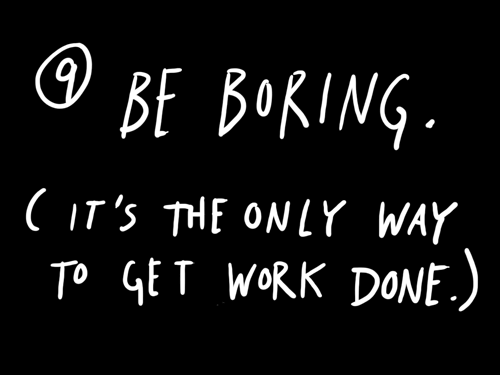
9. Be boring. It’s the only way to get work done.
As Flaubert said, “Be regular and orderly in your life, so that you may be violent and original in your work.”
I’m a boring guy with a 9-5 job who lives in a quiet neighborhood with his wife and his dog.
That whole romantic image of the bohemian artist doing drugs and running around and sleeping with everyone is played out. It’s for the superhuman and the people who want to die young.
The thing is: art takes a lot of energy to make. You don’t have that energy if you waste it on other stuff.
Some things that have worked for me:
Take care of yourself.
Eat breakfast, do some pushups, get some sleep. Remember what I said earlier about good art coming from the body?
Stay out of debt.
Live on the cheap. Pinch pennies. Freedom from monetary stress means freedom in your art.
Get a day job and keep it.
A day job gives you money, a connection to the world, and a routine. Parkinson’s law: work expands to fill the time allotted. I work a 9-5 and I get about as as much art done now as I did when I worked part-time.
Get yourself a calendar. (And a logbook.)
You need a chart of future events, and you need a chart of past events.
Art is all about the slow accumulation over time. Writing a page one day doesn’t seem like much. Do it for 365 days and you have a big novel.
A calendar helps you plan work. This is the calendar I used for my book:
A calendar gives you concrete goals, keeps you on track, and the nice reward of crossing things off and watching the boxes fill up.
Any goal you want to accomplish: get yourself a calendar. Break the task down into little bits of time. Make it a game.
For past events, I suggest a logbook. It’s not a regular journal, it’s just a little book in which you list the things you do every day. You’d be amazed at how helpful having a daily record like this can be, especially over several years.
Marry well.
It’s the most important decision you’ll ever make.
And marry well doesn’t just mean your life partner — it also means who you do business with, who you befriend, who you choose to be around.
10. Creativity is subtraction.
It’s often what an artist chooses to leave out that makes the art interesting. What isn’t shown vs. what is.
In this age of information overload and abundance, those who get ahead will be the folks who figure out what to leave out, so they can concentrate on what’s important to them.
Devoting yourself to something means shutting out other things.
What makes you interesting isn’t just what you’ve experienced, but also what you haven’t experienced.
The same is true when you make art: you must embrace your limitations and keep moving.
Creativity isn’t just the things we chose to put in, it’s also the things we chose to leave out. Or black out.
And that’s all I think I have.
Thanks, y’all.
(Austin Kleon)
Subscribe to:
Comments (Atom)











